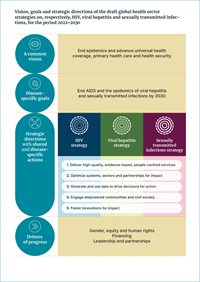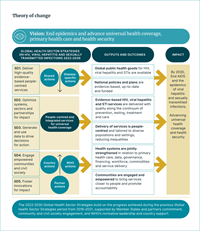Global health sector strategies 2022-2030
The Seventy-Fifth World Health Assembly noted with appreciation the new Global Health Sector Strategies on, respectively, HIV, viral hepatitis and sexually transmitted infections for the period 2022-2030 (GHSS) and approved its implementation for the next 8 years.
The new strategies propose a common vision to end epidemics and advance universal health coverage, primary health care and health security in a world where all people have access to high-quality, evidence-based and people-centred health services. The GHSS promote the disease-specific goals to end AIDS and the epidemics of viral hepatitis and sexually transmitted infections by 2030, with 5 strategic directions providing the overall guiding framework for achieving these goals.
Report on progress and gaps
In 2022, the Seventy-fifth World Health Assembly (Resolution A75/VR/9) requested the Director-General to report on the progress made in the implementation of the Global health sector strategies 2022-2030 (GHSS) to the Health Assembly in 2024, 2026, 2028 and 2031, noting that the 2026 report will provide a mid-term review based on the progress made in meeting the strategies’ 2025 targets and the 2030 goals.
The report “Implementing the global health sector strategies on HIV, viral hepatitis and sexually transmitted infections, 2022–2030: report on progress and gaps 2024”, is the first of a series of biennial progress reports on the implementation of the GHSS.
The 2024 report emphasizes how latest data show that case notifications of sexually transmitted infections are increasing rather than decreasing in many regions, and new HIV and viral hepatitis infections are not declining as fast as they should to achieve the 2030 goals. While the ambitious targets for 2025 and 2030 are helping to drive progress – the progress is patchy across the disease areas and requires an urgent acceleration of effort from Members States for a long-term success.
Implementing the global health sector strategies on HIV, viral hepatitis and sexually...
Seventy-seventh World Health Assembly - Provisional agenda item 29: Matters for information: progress reports - Report by the Director-General, document A77/33 (PDF, 320 KB)



